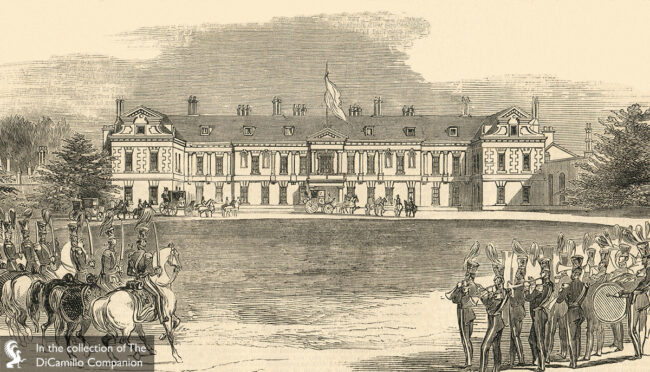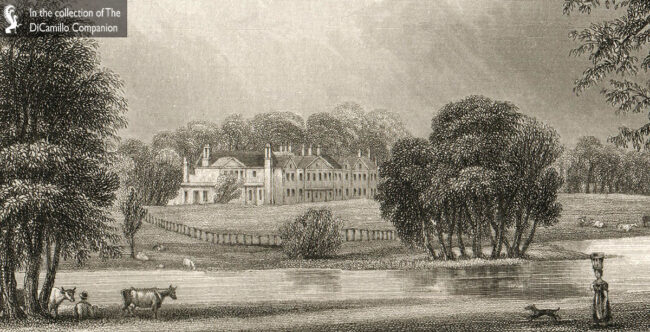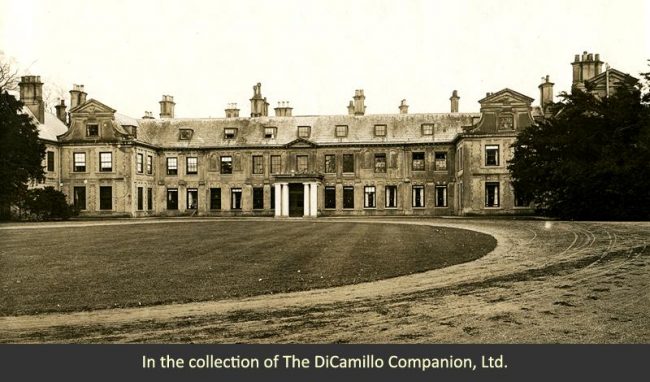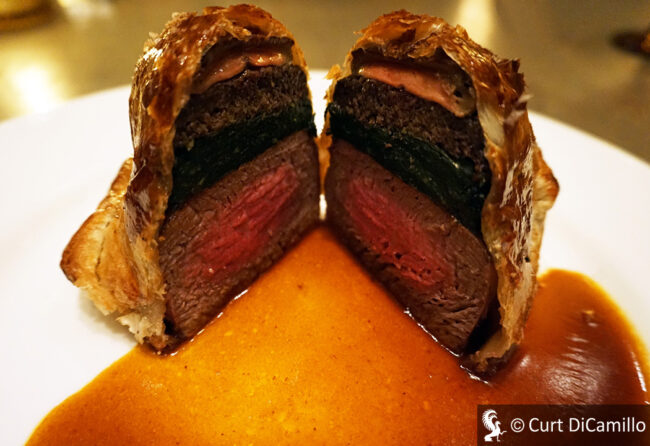
The entrance facade showing the arriving of Queen Victoria in 1845. From "The Illustrated London News."

The house from an 1839 engraving

The entrance facade from a circa 1910 photo

Beef Wellington
Earlier Houses: There was at least one earlier house on, or near, the site of the current house. Some elements of these earlier houses were incorporated into the current house.
House & Family History: The core of the house and the stableblock were built in the 17th century by Sir William Pitt, comptroller of the household to James I. His descendant, George Pitt, 1st Baron Rivers, had the brick house faced in a warm, ochre stucco in the 18th century. In 1817 the 2nd Lord Rivers sold the house and its 5,000-acre estate to Parliament, who presented it to Arthur Wellesley, 1st Duke of Wellington (the "Iron Duke"), as a reward for his victories in the Napoleonic wars. The original intention was that the existing house was to be demolished and with replaced with Waterloo Palace, a vast new house that was to rival Blenheim Palace, the gift from the nation to the 1st Duke of Marlborough for his military victories over the French in the early 18th century. This, of course, never happened—primarily because the massive project was going to cost too much. Instead, the more modest Stratfield Saye House was kept and later enlarged and altered. The 1st Duke went on to have an illustrious career as prime minister and, later, as an elder statesman. In was in this latter role that he received Queen Victoria and Prince Albert for a visit at Stratfield Saye in January of 1845. The queen wrote in her journal of the house: "Stratfield Saye is a low and not very large house but warm and comfortable with a good deal of room in it.” In the 1860s the 2nd Duke of Wellington suggested that excavations be carried out at the old Roman town of Calleva Atrebatum, near Silchester, which he owned. The excavations, which were performed from 1864 until 1878 and from 1890 to 1909, resulted in many important finds, including a small Roman mosaic floor that was installed in the hall of Stratfield Saye House, where it remains today. The Reading Museum maintains an important archive of over 600 photographs that document these early excavations at Silchester. The impressive gallery was originally a 1790s print room that was altered in the 1890s, when the 3rd Duchess put wooden beading around each print and gold leafed the walls. The steak dish Beef Wellington (see "Images" section) is generally believed to have been named after the 1st Duke of Wellington, though no firm proof of this has ever been discovered. The dish, made of fillet steak coated with pâté and duxelles and baked in puff pastry, may actually have been a rebranding of the French filet de bœuf en croute. This early 19th century appropriation of a French dish by the British fits in historically, considering the substantial British celebrations of the 1st Duke’s defeat of Napoleon at the Battle of Waterloo in 1815. Conversely, it has also been suggested that the dish was named Beef Wellington because the joint of beef resembled one of the brown leather military boots worn by the 1st Duke of Wellington. These famous boots, called Wellington boots, or wellies, were most assuredly named after the celebrated duke, who had his London shoemaker adapt an 18th century Hessian military riding boot into a boot that was hard-wearing enough for military use, but dressy enough for informal evening wear. These days wellies have evolved into rubber waterproof boots that are used for a variety of outdoor activities.
Collections: Stratfield Saye has a fine collection of Boulle furniture that was acquired by the 1st Duke of Wellington in Paris. Tommaso di Stefano Lunetti's "Adoration," dated 1813, was was sold at Christie's on June 26, 1979 for £42,000. The painting was given to the 1st Duke of Wellington by King Ferdinand VII of Spain (it was seized from Joseph Bonaparte's luggage train at Vittoria). Sir Francis Grant's "Melton Hunt Going to Draw Ram's Head Covert," purchased by the 1st Duke from the artist in 1839, was sold at Christie's on June 22, 1979 for £30,000. Benjamin Dean Wyatt's drawings for Waterloo Palace were sold at Sotheby's on December 11, 1980. The Waterloo Dispatch was sold by negotiation to the British Library in 1989-90.
Garden & Outbuildings: The stableblock is today home to the Wellington Exhibition, which highlights the life and times of the Iron Duke.
Chapel & Church:
Architect: Giovanni Battista Borra
Date: Probably 1750sArchitect: John Pitt
Date: 1755Architect: Benjamin Dean Wyatt
Date: 1838-40John Bernard (J.B.) Burke, published under the title of A Visitation of the Seats and Arms of the Noblemen and Gentlemen of Great Britain and Ireland, among other titles: 2.S. Vol. I, p. 214, 1854.
Country Life: CIV, 1050, 1106, 1162 plan, 1218, 1948. CV, 202 [Furniture & Relics], 1949. CLVII, 899, 982, 1975.
Title: Treasure Houses of Britain, The - SOFTBACK
Author: Jackson-Stops, Gervase (Editor)
Year Published: 1985
Reference: pg. 336
Publisher: Washington, DC: National Gallery of Art (New Haven: Yale University Press)
ISBN: 0300035530
Book Type: Softback
Title: Biographical Dictionary of British Architects, 1600-1840, A - SOFTBACK
Author: Colvin, Howard
Year Published: 1995
Reference: pgs. 145, 757, 1105
Publisher: New Haven: Yale University Press
ISBN: 0300072074
Book Type: Softback
Title: Disintegration of a Heritage: Country Houses and their Collections, 1979-1992, The
Author: Sayer, Michael
Year Published: 1993
Publisher: Norfolk: Michael Russell (Publishing)
ISBN: 0859551970
Book Type: Hardback
House Listed: Grade I
Park Listed: Grade II
Current Seat / Home of: Arthur Charles Valerian Wellesley, 9th Duke of Wellington; Wellesley family here since 1817.
Past Seat / Home of: SEATED AT EARLIER HOUSES: Stoteville family, 12th century. Saye (Say) family, 13th century. Sir Nicholas D'Abrichecourt, 14th century; Dabrichecourt family here until 1629. Sir William Pitt, 1629-33. SEATED AT CURRENT HOUSE: Sir William Pitt, 1633-36; Edward Pitt, 1636-43; George Pitt, 1643-94; George Pitt, 1st Baron Rivers (fourth creation), until 1803; George Pitt, 2nd Baron Rivers, 1803-17. Field Marshal Arthur Wellesley, 1st Duke of Wellington, 1817-52; Lieutenant-General Arthur Richard Wellesley, 2nd Duke of Wellington, 1852-84; Henry Wellesley, 3rd Duke of Wellington, 1884-1900; Arthur Charles Wellesley, 4th Duke of Wellington, 1900-34; Arthur Charles Wellesley, 5th Duke of Wellington, 1934-41; Henry Valerian George Wellesley, 6th Duke of Wellington, 1941-43; Gerald Wellesley, 7th Duke of Wellington, 1943-72; Brigadier Arthur Valerian Wellesley, 8th Duke of Wellington, 1972-2014.
Current Ownership Type: Individual / Family Trust
Primary Current Ownership Use: Private Home
House Open to Public: Limited Access
Phone: 01256-882-694
Fax: 01256-881-466
Email: [email protected]
Website: https://wellington.co.uk/
Historic Houses Member: Yes